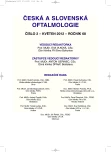The Effect Comparison of Ranibizumab and Sodium Pegaptanib on the Retinal Pigment Epithelium Ablation Size in the Treatment of Age-Related Macular Degeneration
Authors:
M. Šín; M. Jakubcová; O. Chrapek; Z. Prachařová; J. Šimičák; J. Řehák
Authors‘ workplace:
Oční klinika FN a UP, Olomouc, přednosta: doc. MUDr. Jiří Řehák CSc., FEBO
Published in:
Čes. a slov. Oftal., 68, 2012, No. 2, p. 57-60
Category:
Original Article
Overview
Aim:
To evaluate the effect difference of Ranibizumab and Sodium Pegaptanib in the ablation treatment of the retinal pigment epithelium (RPE) in age-related macular degeneration
Material and methods:
Retrospective analysis of data of patients with age-related macular degeneration treated by means of anti-VEGF therapy at the Department of Ophthalmology, School of Medicine, Palacký University, Olomouc, Czech Republic, E.U. during the period May 2009 – October 2010. For the analysis were used data from patients with follow-up period longer than 6 months and present serous RPE ablation caused by occult choroidal neovascularization (CNV), verified by optic coherence tomography (OCT) and fluoresceine angiography (FAG).
Study group:
Ranibizumab was used as treatment during the period in 37 eyes of 37 patients (average age 73.2 years; right eye (RE) in 20 cases, left eye (LE) in 17 cases. Sodium pegaptanib was applied in 17 eyes of 17 patients (average age 72.4 years; RE in 10 cases and LE in 7 cases), The follow-up period in the ranibizumab group was 8.51 (SD 3.32) months, and in the pegaptanib group 9.94 (SD 5.50) months.
Results:
In the ranibizumab group decreased the average RPE ablation base from 2865 μm (SD 810 μm) to 2270 μm (SD 1265 μm) and the prominence of the ablation from 334 μm (SD 160) to 238 μm (SD 178 μm). In patients treated by pegaptanib, decreased the average basis from 3245 μm (SD 930 μm) to 2159 μm (SD 1185 μm), and the prominence of the ablation from 354 μm (SD 173 μm) to 208 μm (SD 107 μm). The statistical significance test did not prove significant differences (level of significance p = 0.05) in the change either of the base or the prominence of the RPE ablation in any group of patients (prominence p = 0.09, base p = 0.21; Mann-Whitney test). In three patients (8.1 %) treated by ranibizumab, the RPE rupture occurred. No RPE rupture was recorded in patients treated by sodium pegaptanib.
Conclusion:
Although no statistically significant difference in the efficacy of both drugs in the treatment of the RPE ablation was found, in patients treated by sodium pegaptanib, there is evident tendency of higher efficacy in decrease of the RPE ablation prominence, and lower incidence of RPE rupture. The study is limited by small number of patients and short follow-up period.
Key words:
age-related macular degeneration, retinal pigment epithelium ablation, retinal pigment epithelium rupture, ranibizumab, sodium pegaptanib
Sources
1. Ahuja, R.M., Stannga, P.E., Vingerling, J.R., et al.: Polypoidal choroval vasculopathy in exsudative and hemorrhagic pigment epithelial detachment, Br J Ophtalmol, 84; 2000: 479–484.
2. Casswell, A.G., Kohen, D., Bird, A.C.: Retinal pigment epithelial detachments in the elderly: classification and outcome, Br J Ophthalmol, 69; 1985: 397–403.
3. CATT Research Group, Martin, D.F., Maguire, M.G., et al.: Ranibizumab and bevacizumab for neovascular age-related macular degeneration, N Engl J Med. 364; 2011: 1897–908.
4. Cunningham, E.T.Jr., Feiner, L., Chung, C. et al.: Incidence of retinal pigment epithelial tears after intravitreal ranibizumab injection for neovascular age-related macular degeneration, Ophthalmology, 118; 2011: 2447–2452.
5. Gragouhas, E.S., Adami, A.P., Cunningham, E.T., et al.: VEGF inhibation study in ocular neovaskularisation clinical trial group. Pegaptanib for neovascular age-relatd macular degeneration. N Engl J Med. 351; 2004: 2805–2816.
6. Hoskin, A., Bird, A.C., Sehmi, K.: Tears of detached retinal pigment, Br J Ophthalmol., 65; 1981: 417–422.
7. Chan, C.K., Abraham, P., Meyer, C.H., et al.: Optical coherence tomography-measured pigment epithelial detachment height as a predictor for retinal pigment epithelial tears associated with intravitreal bevacizumab injections, Retina, 30; 2010: 203–211.
8. Chang, L.K., Sarraf, D.: Tears of the RPE: an old problem in a new era, Retina, 27; 2007: 523–527.
9. Chrapek, O., Pitrová, Š., Dušek, L., et al.: Výsledky léčby vlhké formy věkem podmíněné makulární degenerace u pacientů evidovaných v celonárodním registru AMADEUS, Čes a lov Oftal, 66; 2010: 110–118.
10. Ischida, S., Usui, T., Yamasiro, K., t al.: VEGF 164-mediated inflamtion is required for patological but not physiological, ischemia-induce retinal neovascularisation, J Exp Med, 198; 2003: 483–489.
11. Khetpal, V., Heimmel, M.R., Rao, S.K., et al.: Resolution of retinal pigment epithelial detachment associated with exsudative age-related macular degeneration following intravitreal ranibizumab therapy, Acta Ophthalmol, 87; 2009: 115–116.
12. Lommatzsch, A.P., Heimes, B., Gutfleisch, M., et al.: Serous pigment epithelial detachment in age-related macular degeneration: comparison of different treatments, Eye, 23; 2009: 2163–2168.
13. Lommatzsch, A.P., Heimes B., Gutfleisch M., et al.: Treatment of vascularised serous pigment epithelium detachment in AMD - observations after changing the intravitreal agent due to lack of response, Klin Monatsbl Augenheilkd, 225; 2008: 874–879.
14. Manish, N., Kamal, N., Nagpal, M.S.: A comparative debate on the various anti-vascular endothelial growth factor drugs: Pegaptanib sodium (Macugen), ranibizumab (Lucentis) and bevacizumab (Avastin), Ind J Oph, 55; 2007: 437–439.
15. Pauleikhoff, D., Loffert, D., Spital, G., et al.: Pigment epithelial detachment in the eldery – clinical differentiation, natural course and pathogenetic implications, Graef. Arch Clin Exp Oph, 240, 2004: 533–538
16. Studnička J.: Ranibizumab (Lucentis) v léčbě věkem podmíněné makulární degenerace, Čes a lov Oftal, 65; 2009: 107–111.
17. Šín M., Šimičák J., Prachařová Z., et al.: Pegaptanib sodný a ranibizumab v léčbě ablace pigmentového listu sítnice u pacienta s věkem podmíněnou makulární degenerací – kazuistika, Čes a slov Oftal, 66; 2010: 138–141.
Labels
OphthalmologyArticle was published in
Czech and Slovak Ophthalmology

2012 Issue 2
Most read in this issue
- Repeatability and Reliability of the Visual Acuity Examination on logMAR ETDRS and Snellen Chart
- Acute Retinal Necrosis
- The Diabetic Macular Edema – New Possibilities of the Treatment
- Evaluation of Bacterial Colonization of the Conjunctival Sac in Ranibizumab Intravitreal Injections Treated Patients
